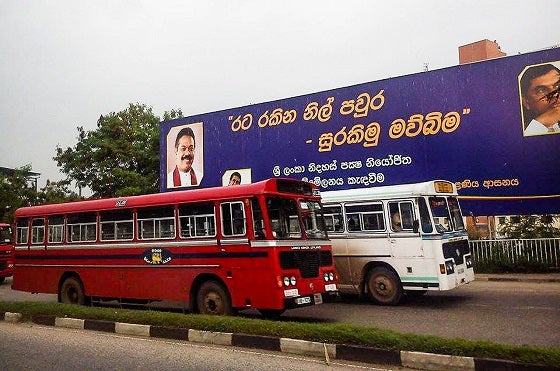Sri Lanka’s Presidential Election 2019: Analysing Past and Present Voting Patterns
Chulanee Attanayake
16 November 2019Summary
Sri Lanka’s eighth presidential election is just around the corner. Campaigning has come to a close and people are now processing the policies and action plans, and weighing the strengths and the weaknesses of the candidates. Amidst this backdrop, this paper analyses past and present voting patterns in Sri Lanka
The 2015 Presidential Election
The 2015 presidential Election is one of the most analysed Sri Lankan elections, both locally and internationally. The then incumbent president, Mahinda Rajapaksa, was seeking an unprecedented third-term in power. He was the candidate from the United People’s Freedom Alliance (UPFA), the political alliance led by the Sri Lanka Freedom Party (SLFP). Brushing aside requests from his allies not to call an early election, Rajapaksa announced that an election would be held two years ahead of its scheduled time.
The main opposition candidate, Maithripala Sirisena, was the former Minister of Health in Rajapaksa’s government and general secretary of the SLFP. Sirisena defected a day after Rajapaksa announced that there would be a snap election and contested as the common candidate of an alliance formed by opposition parties. Rajapaksa faced criticisms over the deterioration of democratic institutions, rising government debt and his China-centric foreign policy. His government was also accused of bribery, corruption and nepotism. However, he remained a popular figure and was celebrated by his supporters as a war hero for his government’s role in ending the almost three-decade long civil war against the Liberation Tigers of Tamil Eelam (LTTE). Thus, defeating Rajapaksa was considered by many as impossible. However, Sirisena ousted Rajapaksa in a shocking victory. His victory was made possible in part by the fact that he promised an end to the centralisation of power of Rajapaksa’s presidency. This enabled him to stitch together a coalition of unlikely allies, representing differing political ideologies. He also managed to convince some ministers and members of parliament from the incumbent government cross over to support the opposition.
With a voter turnout of 81.53 per cent, the 2015 presidential election had the highest voter participation in any recent presidential election in Sri Lanka. Sirisena received 51.28 per cent of the votes while Rajapaksa received 47.58 per cent of the votes. The voting patterns of constituencies clearly reflected ethnic and religious polarisation. While Sirisena, with the backing of the United National Party (UNP)-led coalition, received a large majority (73.5 per cent) of the votes from the Tamil and Muslim dominant regions in the North and the East, Rajapaksa received a majority (50.45 per cent against 48.54 per cent) of the votes from the Sinhala dominant South. This reveals that, despite the erosion of support witnessed in previous elections, Rajapaksa held on to his strong vote base outside of the North and the East. On its part, the UNP-led coalition’s strongholds were mostly in the North and the East
Voting Patterns
The political landscape during this presidential election is different from that of the previous one. Unlike in 2015, there is mounting public support for a return of the Rajapaksas (Mahinda Rajapaksa and Gotabaya Rajapaksa). The incumbent government has become extremely unpopular, due to its inefficiency and failure to deliver on election promises in the past four and a half years. This anti-incumbency tide was evident in the 2018 Local Government election when people voted in favour of the Mahinda Rajapaksa-backed Sri Lanka Podujana Party (SLPP) against Prime Minister Ranil Wickremesinghe’s UNP and Sirisena’s SLFP.
It is also important to note that political alliances that existed during the 2015 presidential election have changed significantly. Tellingly, Sirisena’s political party left its alliance with the UNP and is now supporting the Rajapaksa camp. The Janatha Vimukthi Peramuna (JVP), which had also supported the UNP alliance against Rajapaksa during the 2015 election, is now contesting on its own. Moreover, for the first time in history, there are 35 candidates contesting this election, and the majority of them will contest for different voting blocks in the South. Therefore, new voting patterns can be expected this time round. It is also likely to be a challenge for the main two contenders to cross the 50 per cent threshold in this election.
Judging from the results of recent elections, it can be assumed that Rajapaksa has a firm support base of 40-45 per cent in the South. Hence, Gotabaya, who is backed by Mahinda Rajapaksa, is likely to win the support of at least 40 per cent of the voters. On the contrary, the Local Government polls in 2018 revealed that the UNP candidate Sajith Premadasa’s support base in the South is around 31.46 per cent. This marks a dramatic decline from its vote share of 48.5 per cent in the 2015 presidential election. This decline is the result of anti-incumbent sentiments amongst the voters. It is also due to the fact that the JVP and SLFP-Sirisena faction, which supported the UNP in 2015, have defected from the alliance.
In sum, in this election, the gap between the main two candidates in the South and the North will have a significant impact on the result. Furthermore, the floating votes in the South, those of the Muslim community and other demographic blocks such as the business and public sectors will play a decisive role. It is clear from the results of the presidential election in 2015, that even after getting 46.68 per cent of the votes from the North and the East, the UNP-led coalition only won the presidential election by 3.7 per cent. We are in for an interesting election
….
Dr Chulanee Attanayake is a Visiting Research Fellow at the Institute of South Asian Studies (ISAS), an autonomous research institute at the National University of Singapore (NUS). She can be contacted at chulanee@nus.edu.sg. The author bears full responsibility for the facts cited and opinions expressed in this paper
-
 More From :
More From :
-
 Tags :
Tags :
-
 Download PDF
Download PDF



